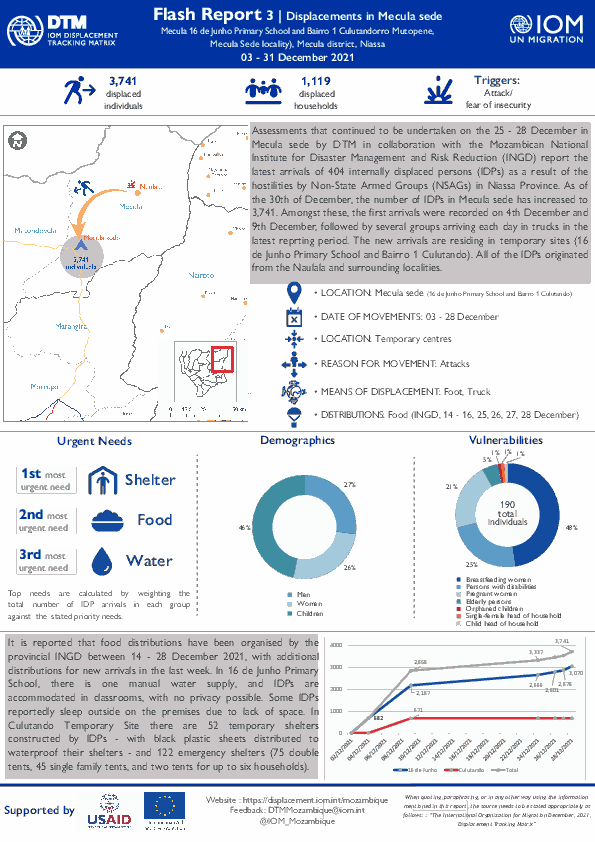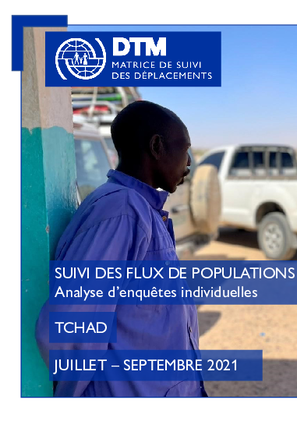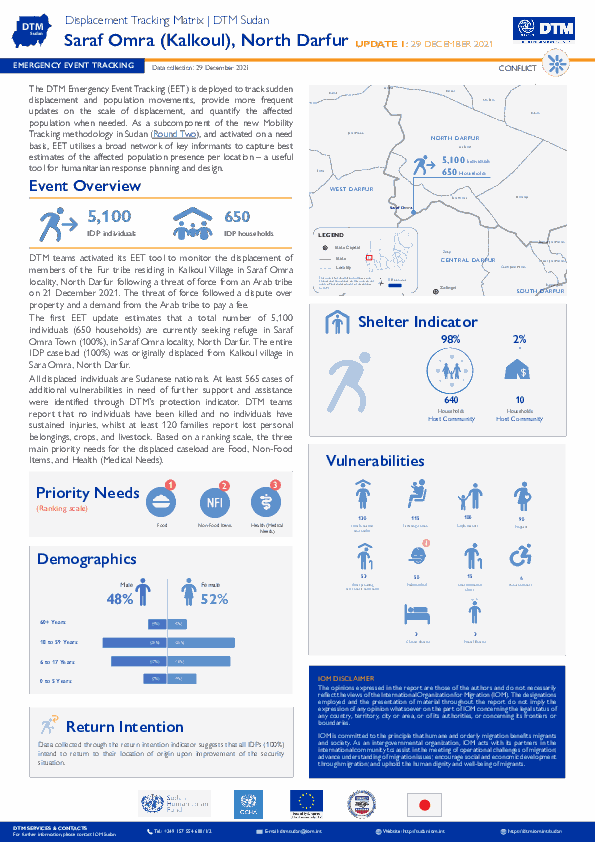-
Countries
-
Data and Analysis
-
Special Focus
-
Crisis Responses

Contact
DTMMozambique@iom.int
Language
English
Location
Mozambique
Period Covered
Dec 23 2021
Dec 28 2021
Activity
- Event Tracking
- Mobility Tracking
During the reporting period (23 to 28 December 2021), a total of 16 movements were recorded - 6 transits (115 individuals), 2 departures (33 individuals), 4 arrivals (26 individuals), and 4 intended return movements (74 individuals). The largest individual arrival was recorded in Ancuabe (19 individuals). The largest intended return movements were observed in Nanagde (74 individuals). The largest transit was recorded in Nangade (115 individuals). The largest departures were recorded in Balama (24 individuals). Of the total population 9 per cent were displaced for the first time, and 91 per cent of reported IDPs had been displaced more than once prior to this latest movement.

Contact
DTM Mozambique, DTMMozambique@iom.int
Language
English
Location
Mozambique
Period Covered
Dec 25 2021
Dec 28 2021
Activity
- Event Tracking
- Site Assessment
- Mobility Tracking
Assessments that continued to be undertaken on the 25 - 28 December in Mecula sede by DTM in collaboration with the Mozambican National Institute for Disaster Management and Risk Reduction (INGD) report the latest arrivals of 404 internally displaced persons (IDPs) as a result of the hostilities by Non-State Armed Groups (NSAGs) in Niassa Province. As of the 30th of December, the number of IDPs in Mecula sede has increased to 3,741. Amongst these, the first arrivals were recorded on 4th December and 9th December, followed by several groups arriving each day in trucks in the latest reprting period. The new arrivals are residing in temporary sites (16 de Junho Primary School and Bairro 1 Culutando). All of the IDPs originated from the Naulala and surrounding localities.

Contact
DTM Nigeria, AllUsersInDTMNigeria@iom.int
Language
English
Location
Nigeria
Period Covered
Dec 20 2021
Dec 26 2021
Activity
- Event Tracking
- Mobility Tracking
The DTM Emergency Tracking Tool (ETT) is deployed to track and collect information on large and sudden population movements, provide frequent updates on the scale of displacement and quantify the affected population when needed. As a subcomponent of the Mobility Tracking methodology in Nigeria, ETT utilizes direct observation and a broad network of key informants to capture best estimates of the affected population per location, enabling targeted humanitarian response planning.
Between 20 and 26 December 2021, a total of 3,875 movements were recorded in the states of Adamawa and Borno. The recorded movements consisted of 3,381 arrivals and 494 departures. Arrivals were recorded at locations in Askira/Uba, Bama, Gwoza, Kala/Balge, Monguno and Ngala Local Government Areas (LGAs) of the most conflict-affected state of Borno and in Fufore, Gombi, Hong, Maiha, Michika, Mubi South, Yola North and Yola South LGAs of Adamawa.
Departures were recorded in Askira/Uba, Kala/Balge and Konduga LGAs of Borno, and Fufore, Lamurde, Maiha, Michika, Song and Yola North LGAs of Adamawa.
ETT assessments identified the following movement triggers: voluntary relocation (1,498 individuals or 39%), conflicts/attacks (944 individuals or 24%), camp closure/government-assisted relocation (877 individuals or 23%), poor living conditions (349 individuals or 9%), improved security (112 individuals or 3%), fear of attacks (59 individuals or 1%) and seasonal farming (36 individuals or 1%).
Contact
DTM Nigeria, AllUsersInDTMNigeria@iom.int
Location
Nigeria
Activity
- Other
- Mobility Tracking
- Site Assessment
Period Covered
Aug 30 2021 -Oct 15 2021
This KMZ files can contain placemarks featuring a custom name; the latitudinal and longitudinal coordinates for the locationof all the IDPs sites assessed during the round {#}. KMZ files can be opened by Google Earth, or unzipped with a compression utility, such as WinZip on Windows, MacZip for Macintosh users, and Zip and UnZip for UNIX systems.
Population Groups
Survey Methodology
Unit of Analysis Or Observation
Type of Survey or Assessment
Keywords
Geographical Scope
Administrative boundaries with available data
The current dataset covers the following administrative boundaries
Contact
DTM Nigeria, AllUsersInDTMNigeria@iom.int
Location
Nigeria
Activity
- Other
- Mobility Tracking
- Site Assessment
Period Covered
Aug 30 2021 -Oct 15 2021
This KMZ files can contain placemarks featuring a custom name; the latitudinal and longitudinal coordinates for the locationof all the IDPs sites assessed during the round {#}. KMZ files can be opened by Google Earth, or unzipped with a compression utility, such as WinZip on Windows, MacZip for Macintosh users, and Zip and UnZip for UNIX systems.
Population Groups
Survey Methodology
Unit of Analysis Or Observation
Type of Survey or Assessment
Keywords
Geographical Scope
Administrative boundaries with available data
The current dataset covers the following administrative boundaries
Contact
DTM Nigeria, AllUsersInDTMNigeria@iom.int
Location
Nigeria
Activity
- Other
- Mobility Tracking
- Site Assessment
Period Covered
Aug 30 2021 -Oct 15 2021
This KMZ files can contain placemarks featuring a custom name; the latitudinal and longitudinal coordinates for the locationof all the IDPs sites assessed during the round {#}. KMZ files can be opened by Google Earth, or unzipped with a compression utility, such as WinZip on Windows, MacZip for Macintosh users, and Zip and UnZip for UNIX systems.
Population Groups
Survey Methodology
Unit of Analysis Or Observation
Type of Survey or Assessment
Keywords
Geographical Scope
Administrative boundaries with available data
The current dataset covers the following administrative boundaries

Contact
DTM Nigeria, AllUsersInDTMNigeria@iom.int
Language
English
Location
Nigeria
Period Covered
Aug 30 2021
Oct 15 2021
Activity
- Mobility Tracking
- Baseline Assessment
In response to the need for accurate and up-to-date information on human mobility and forced displacement in north-east Nigeria, IOM activated its Displacement Tracking Matrix (DTM) to support the Government and the humanitarian community with
multi-layered data on the numbers, trends, status, locations and needs of populations affected by the on-going conflict in north-east Nigeria. Round 39 of assessment was conducted from 30 August to 15 October 2021.
This dashboard provides key figures on the numbers, demographic profile, location and accommodation arrangement of returnees. A total of 1,943,445 returnees were recorded in the DTM Round 39 assessment. including 1,786,667 Former IDP Returnees and 156,778 Returnees from abroad. This represents an increase of 25,382 individuals or 1 per cent compared to Round 38.

Contact
DTM Mauritania, DTMMauritania@iom.int
Language
French
Location
Mauritania
Period Covered
Sep 01 2021
Sep 30 2021
Activity
- Survey
- Flow Monitoring
La transhumance est une tradition de longue date en Mauritanie où elle a subi des évolutions majeures au cours des dernières décennies, comme la raréfaction des ressources impliquant la redéfinition des routes empruntées par les troupeaux. Par conséquent, des conflits peuvent survenir lorsque les agriculteurs et les transhumants utilisent les mêmes ressources ou quand les champs agricoles sont endommagés par le passage des troupeaux. Dans le cadre du Suivi des Mouvements de Transhumance, l’OIM met en œuvre un système d’alerte, qui a pour objectif de recenser les mouvements inattendus de bétail et conflits ou catastrophes naturelles liés à l’utilisation des ressources naturelles et aux pratiques agro-pastorales dans la région, de comprendre les modes de résolution de conflits existants et d’informer les autorités compétentes, dans l’objectif de réduire les tensions dans les régions d’intervention. Ce tableau de bord présente les informations fournies par le biais de 37 relais communautaires, présents dans sept régions (Trarza, Brakna, Gorgol, Guidimakha, Assaba, Hodh El Chargui et Hodh El Gharbi) pendant le mois de septembre 2021.

Contact
DTM Chad, dtmtchad@iom.int
Language
French
Location
Chad
Period Covered
Jul 01 2021
Sep 30 2021
Activity
- Survey
- Flow Monitoring Survey
- Flow Monitoring
Afin de mieux comprendre les mouvements et tendances migratoires en Afrique de l’Ouest et du Centre, l’OIM, à travers la Matrice de suivi des déplacements (Displacement Tracking Matrix, DTM), met en œuvre l’activité de Suivi des flux de populations (Flow Monitoring, FM).
Le suivi des flux, mis en œuvre en étroite collaboration avec les autorités et des partenaires nationaux et locaux, est composé de deux outils: l’enregistrement des flux (Flow Monitoring Registry, FMR) et les enquêtes individuelles (Flow Monitoring Survey, FMS).
Il récolte des données clés sur les flux migratoires, les profils des voyageurs et les parcours et intentions des migrants, afin de fournir une meilleure compréhension des flux migratoires dans la région et contribuer à l’élaboration des poliltiques migratoires basées sur des évidences.
À cet effet, plusieurs points de suivi des flux de population (Flow Monitoring Point, FMP) sont installés dans des zones de transit importantes. Durant le troisième trimestre de 2021, les FMP de Faya et d’Ounianga Kébir, respectivement situés dans les provinces du Borkou et de l’ Ennedi Ouest, au nord Tchad, ont été actifs.
Ce rapport présente donc les données clés collectées entre juillet et septembre 2021 au niveau de ces deux FMP. Le rapport est subdivisé en deux sections:
-une section présentant les données obtenues lors de l’enregistrement des flux (FMR).
-une autre section présentant les résultats des enquêtes individuelles effectuées auprès des voyageurs (FMS).

Contact
DTM Sudan; dtmsudan@iom.int
Language
English
Location
Sudan
Snapshot Date
Dec 29 2021
Activity
- Event Tracking
- Mobility Tracking
The DTM Emergency Event Tracking (EET) is deployed to track sudden displacement and population movements, provide more frequent updates on the scale of displacement, and quantify the affected population when needed. As a subcomponent of the new Mobility Tracking methodology in Sudan (Round Two), and activated on a need basis, EET utilises a broad network of key informants to capture best estimates of the affected population presence per location – a useful tool for humanitarian response planning and design.
